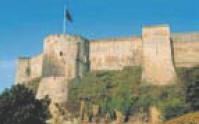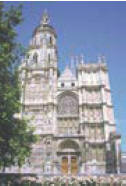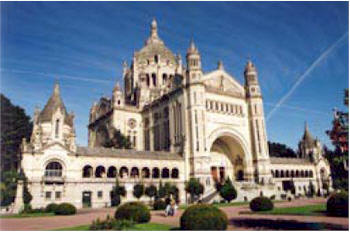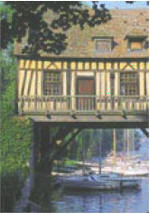Time for a real culture break in Normandy–a stone’s throw from Paris–but soooo refreshing
Alençon
Situated on the crossroads between the routes from Brittany to Paris and from Belgium to the Loire Valley, Alençon is an ideal stopover point for visitors travelling further afield, yet also offers much worth spending time to visit.

Dukes’ Palace in Vernon, Normandy
Once known as the “Cité des Ducs”, the town boasts a fine old town hall, 15th century church as well as the Dukes’ Palace dating from the 14th and 15th centuries.
However, it is most famous for its lace making tradition which gave the name to the “Alençon stitch” and there are two museums dedicated to this important heritage, including the Musée des Beaux-Arts et de la Dentelle.
Famous too for its links with St Thérèse who was born in the town in 1873, Alençon’s St Leonard district is an attractive architectural mix of newer and older buildings, with their spiral staircases and iron balconies, in the Medieval streets. By train from Paris Montparnasse and also on the Caen-Tours main line.
Bayeux
Essentially a medieval town, whose cathedral was dedicated in 1077 by William the Conqueror, Bayeux is also home to the famous tapestry depicting William’s epic journey to England and the Battle of Hastings.
Intrinsically linked with the events of June 1944, the town provided headquarters for General de Gaulle after D-Day, now a museum. There is also a Museum dedicated to the Battle of Normandy whilst the British War Cemetery is within walking distance of the town centre.
The town itself miraculously avoided any destruction during Allied bombings, a fact which is clearly evident in the preserved medieval structure of its buildings and streets.
In addition to the Tapestry and cathedral, tourists can visit the Baron Gérard Museum, with its collections of art, porcelain and lace, or the various craft workshops and art galleries within the town.
There is also a busy commercial centre where you will find shops, restaurants and hotels, including a number of brocantes or antique centres. A market is held twice a week, on Wednesdays and Saturdays.
There are regular train services on the route between Paris and Cherbourg. Buses link Bayeux with several local towns such as Arromanches and Port en Bessin.
Caen
Today Caen is a thriving commercial and university centre, with historical roots dating back even before William of William the Conquerors Palace in Caen, NormandyNormandy lent the town his favor in the 11th C.

William the Conqueror Castle
He commissioned the Abbaye aux Hommes as well as the Abbaye aux Dames, built for his wife mathilde and now her final resting place. Both buildings surviving the destruction of bombardments in 1944.
The city was rebuilt after the War, and present day Caen offers an appealing mix of old and new with plenty of well-maintained green spaces. Various markets are held daily.
Most visitors to Caen head straight for the thought-provoking Mémorial, where you can easily spend a whole day, but also worth a visit is the Jardin Botanique, with its collections of exotic plants, and the city’s Fine Arts Museum housed within the walls of William of Normandy’s castle.
There are 12 trains a day from Paris with a journey time of around 2 hours. There is also a shuttle link with the ferry terminal at Ouistreham plus a good local bus service. The airport has regular flights to French and European cities via the Regional Airlines hub of Lyon.
Cherbourg
Ideally situated as a port for both leisure craft and military ships, Cherbourg has long been a centre for the French navy as well as a popular destination with local and international yachtsmen who enjoy the challenge of the choppy seas and challenging winds.

Cherbourg on the northern extremity of the Manche
The town was once also the centre for transatlantic liners, and in its heyday saw many a famous celebrity arrive or depart from the Gare Maritime.
Now transformed into the Cité de la Mer, an impressive museum dedicated to the world undersea and exhibiting the world’s largest submarine open to the public, this building is an architectural reminder of the town’s glamorous past.
A lively town, with numerous quayside restaurants and hotels as wells as a bustling commercial centre plus several colorful markets, Cherbourg also has one of the most exotic-looking buildings in the area – a 19th C “Italian-style” theatre, vaguely reminiscent of Monaco’s Casino Square.
For art lovers, the Thomas Henry Fine Arts Museum boasts a good collection of works by local artist Millet, and for visitors on the Second World War trail there is a Museum dedicated to the Liberation.
Access by ferry services from the UK and Ireland, plus regular trains from Paris.
Dieppe
A genuine seaside resort where the seafront has been developed with promenade, grassy lawns and children’s play areas. Dieppe’s streets are busy with shops and restaurants, and the weekly market brings color and tradition to the central square.

Château-museum in Dieppe
The town’s fishing port reaches right into the town itself, explaining its reputation for seafood, in particular the marmite dieppoise, a creamy fish stew, and visitors will be spoilt for choice with the range of cafés and restaurants.
Dieppe was once an important port for the trading of spices and ivory, and its château-museum displays a collection of sculpted ivory worked by local craftsmen as far back as the 16th C plus a collection of Impressionist paintings.
An 18-hole golf course nearby makes Dieppe a good choice for anyone keen to test the quality of Normandy’s golfing venues, and its sporting facilities include tennis courts, water sports plus a large pleasure marina.
Dieppe is also famous for its international kite festival. There is a year round ferry service from Newhaven, as well as regular train services from Paris via Rouen.
Evreux
With ruins dating back to Celtic times, present day Evreux bears witness to a rich and troubled history. Its Gothic cathedral is particularly impressive, built in the 10th centuryGothic Cathedral Evreux, Normandy and with exceptional 14th century stained glass windows.

Cathedral in Evreux
It is connected to the Episcopal Palace which today houses the municipal museum.
Evreux also boasts a 15th century belfry, once a fortified tower at one of the town’s gates, as well as St Taurin’s shrine. Evreux is the county town of the Eure département.
It has a weekly market and a busy town centre, full of the usual shops, cafés and restaurants. It is not far from Monet’s garden at Giverny plus several châteaux, such as Champs de Bataille and Harcourt, all worth a visit.
The town of Evreux is only 60 miles from Paris, therefore benefiting from a regular train service. It is also on the main Cherbourg to Paris line, making it accessible from both ferry ports of Cherbourg and Caen.
Fécamp
This traditional fishing port on the famous Alabaster coast of the Seine-Maritime was once the favorite residence of the Dukes of Normandy and its history is also linked with the Newfoundland fishing industry.

Palais Bénédictine with the world famous distillery
Today it is a bustling town, with several intriguing museums to visit including one about Fécamp’s maritime past and the famous Palais Bénédictine which combines distillery with eclectic collection of objects and art works.
Nominated as an Art & History Town, Fécamp’s tourist office arranges numerous events and tours which will give you an insight into the town’s fascinating history.
Worth seeing are the remains of the Ducal palace, situated in front of the Abbey, as well as the Chapelle Notre-Dame-de-Salut where sailors used to pray before setting out on their dangerous journeys to the cod fishing areas – it has fantastic views over the town and out to sea. Easy access by train from Rouen and by bus from Dieppe and Le Havre.
Le Havre
Le Havre is multi-facetted, as important a commercial port as it is a popular yachting destination. Its 2 km of beach open onto the Seine estuary, once the backdrop for Impressionist artists who loved the effect of light and painted many famous paintings, including Monet’s “Sunrise at Le Havre”.

City of Le Havre with its impressive port
Completely destroyed during the 1944 bombardments, the re- building of Le Havre has now been recognized by UNESCO which added the town to its list of World Heritage Sites in 2005.
Jewel in the crown is the Malraux Museum, an ultra-modern building on the seafront which houses an impressive collection of Impressionist works together with art from preceding centuries up to contemporary works.
There is much else of interest to visit, including the Notre Dame cathedral, Natural History Museum and the Graville Priory, but especially fascinating is the Espace Maritime and the Vauban-designed dock area.
Access is easy, with regular ferry services from the UK and fast train service to Paris and onward destinations including Marseille by TGV. Le Havre also has a daily ferry service with Portsmouth.
Lisieux
The town is today an important commercial and tourist centre, which retains some of its old streets with its half-timbered buildings.

St Pierre cathedral, where Thérèse regularly took part in the Mass
It is perhaps most famous for its links with St Thérèse, the young girl from Alençon, who grew up here. Her dedication to God and subsequent canonization have transformed Lisieux into a place of pilgrimage and there are numerous venues which detail her life in the town.
One such place is the St Pierre cathedral, which dates from the 12th century, where Thérèse regularly took part in the Mass. Other attractions include the Museum of Old Lisieux, which recounts the town’s traditional way of life, and the pretty château, which is a fine and colorful example of typical Auge architecture.
There are numerous events throughout the summer, including illumination of the Basilica and various religious processions to celebrate the life of Ste-Thérèse .
The town holds a weekly market every Saturday, as well as on Wednesdays in the summer. Lisieux is situated on the main Paris to Cherbourg railway line, benefiting from a regular service.
Rouen
Is the Seine-Maritime’s county town, not only an important vibrant city, but also a river port which often sees the arrival of cruise ships and, every four years, of the famous Tall Ships Armada.
The town’s long history dates back over 2000 years but it is intrinsically linked with the life of Joan of Arc, who fought and died (at the stake) in the city. She died on the Place du Vieux Marché, now marked by a modern church built in the 1970s.
Rouen’s cobbled streets invite visitors to explore, offering interesting shops in which to browse and cafés and restaurants in which to linger.
The town is particularly renowned for its antique shops. Other major monuments include the magnificent cathedral, abbey church and famous clock tower. There is also a municipal garden, and the possibility of boat trips on the river.
Rouen has a metro system which facilitates travel within the town, and is linked to Paris and the ferry ports of Le Havre and Dieppe with regular train services. The airport has regular flights to French provincial cities.
Vernon

Vernon with its half-timbered houses
This pretty town, with its 15th C timbered houses, is set on the left bank of the river Seine and is close to Monet’s garden at Giverny, making it the ideal stopping off point for a visit to Vernon with its quaint 15th Century timbered houses the artists’ home.
There are Impressionist works of art in the Poulain Museum at Vernon, although it primarily concentrates on pre-history.
Other sites worth visiting are the Château de Bizy, a sumptuous building which houses memorabilia of the Bonaparte family, and the Notre Dame Church built in gothic style.
Particularly picturesque is the timber fronted house set on the remaining piles of a medieval bridge on the right bank of the Seine.
The Vernon to Gisors bus service departs from the railway station, stopping at Giverny (4km away). Regular train services from Paris St Lazare, and easily accessible from Rouen and Le Havre which are on the same line.
credits : Normandy Tourist Board
Leave a Reply